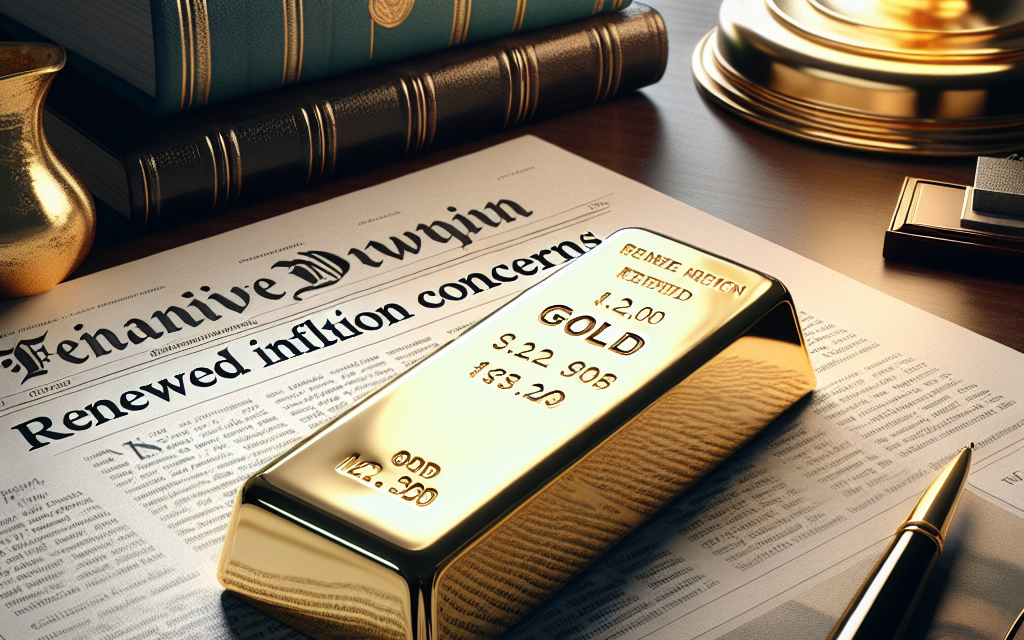“Gold: Your Safe Haven as Inflation Sparks Uncertainty.”
Introduction
As inflationary pressures resurface in global economies, gold has emerged as a beacon of stability and value preservation. Historically viewed as a safe-haven asset, gold tends to attract investors during times of economic uncertainty and rising prices. With central banks grappling with the implications of inflation on monetary policy and consumer purchasing power, the allure of gold shines brighter than ever. This renewed interest underscores gold’s role not only as a hedge against inflation but also as a strategic component in diversified investment portfolios. As market volatility persists, the precious metal’s enduring appeal continues to captivate both seasoned investors and newcomers alike.
Gold’s Historical Performance During Inflationary Periods
Gold has long been regarded as a safe haven asset, particularly during periods of economic uncertainty and inflation. Historically, its performance during inflationary periods has demonstrated a consistent pattern that investors often look to as a barometer for future trends. As inflationary pressures resurface in various economies, understanding gold’s historical performance can provide valuable insights into its potential role in investment portfolios.
Throughout history, gold has served as a hedge against inflation, a characteristic that has been particularly evident during significant economic upheavals. For instance, during the 1970s, the United States experienced a period of stagflation characterized by high inflation and stagnant economic growth. As consumer prices surged, gold prices also escalated dramatically, reaching an all-time high in 1980. This correlation between rising inflation and increasing gold prices solidified the metal’s reputation as a reliable store of value. Investors flocked to gold as a means of preserving their wealth, illustrating the asset’s ability to maintain purchasing power in the face of eroding currency value.
Moreover, the early 2000s presented another compelling case for gold’s performance amid inflationary concerns. Following the dot-com bubble burst and the subsequent financial crisis, central banks around the world implemented expansive monetary policies, leading to fears of inflation. During this period, gold prices soared, reflecting investor sentiment that sought refuge from potential currency devaluation. The metal’s ascent during this time not only highlighted its historical role as a hedge against inflation but also underscored its appeal as a diversifying asset in investment portfolios.
Transitioning to more recent events, the COVID-19 pandemic has reignited inflation fears globally. Governments responded with unprecedented fiscal stimulus measures, which, while necessary to support economies, raised concerns about long-term inflationary effects. As consumer demand rebounded and supply chain disruptions persisted, inflation rates began to climb. In this context, gold once again emerged as a focal point for investors seeking stability. The metal’s price surged in 2020 and 2021, reflecting a renewed interest in its historical role as a safeguard against inflationary pressures.
Furthermore, the relationship between gold and inflation is not merely anecdotal; it is supported by empirical data. Studies have shown that, over the long term, gold tends to outperform other asset classes during inflationary periods. This trend can be attributed to gold’s intrinsic value, which is not tied to any specific currency or economic system. As inflation erodes the purchasing power of fiat currencies, gold retains its value, making it an attractive option for investors looking to protect their wealth.
In conclusion, gold’s historical performance during inflationary periods reveals a consistent pattern of resilience and strength. As inflation concerns resurface in today’s economic landscape, the metal’s role as a hedge against rising prices becomes increasingly relevant. Investors, recognizing the lessons of the past, may find themselves drawn to gold as a means of safeguarding their assets in an uncertain financial environment. Ultimately, the enduring appeal of gold lies in its ability to shine amid the shadows of inflation, offering a beacon of stability for those navigating the complexities of the modern economy.
The Role of Gold as a Safe Haven Asset
In times of economic uncertainty, investors often seek refuge in safe haven assets, and gold has consistently emerged as a preferred choice. This precious metal has a long-standing reputation for preserving wealth, particularly during periods of inflation and market volatility. As inflationary pressures resurface, the allure of gold becomes increasingly pronounced, prompting many to reassess its role in their investment portfolios.
Historically, gold has served as a hedge against inflation. When the purchasing power of fiat currencies declines, as it tends to do during inflationary periods, gold often retains its value or even appreciates. This characteristic is rooted in gold’s intrinsic value, which is not subject to the same fluctuations as paper currencies. Consequently, when inflation rates rise, the demand for gold typically increases, as investors look to safeguard their assets from eroding value. This dynamic has been observed in various economic cycles, reinforcing gold’s status as a reliable store of value.
Moreover, gold’s appeal as a safe haven asset is further bolstered by its limited supply. Unlike fiat currencies, which can be printed in unlimited quantities by central banks, gold is a finite resource. This scarcity contributes to its enduring value, especially in times of economic distress. As central banks around the world implement expansive monetary policies to stimulate growth, the potential for inflation rises, prompting investors to flock to gold as a protective measure. This behavior is not merely a reaction to current economic conditions; it is also a reflection of historical patterns where gold has consistently outperformed other asset classes during inflationary periods.
In addition to its inflation-hedging properties, gold is often viewed as a safe haven during geopolitical tensions and financial crises. When uncertainty looms, whether due to political instability, trade disputes, or global pandemics, investors tend to gravitate towards assets that are perceived as stable. Gold, with its universal acceptance and historical significance, fits this criterion perfectly. As a result, during times of crisis, the demand for gold typically surges, driving up its price and reinforcing its status as a safe haven asset.
Furthermore, the diversification benefits of including gold in an investment portfolio cannot be overlooked. Gold often exhibits a low correlation with other asset classes, such as stocks and bonds. This means that when equity markets are underperforming, gold may provide a counterbalance, helping to mitigate overall portfolio risk. As investors seek to navigate the complexities of the financial landscape, incorporating gold can enhance portfolio resilience, particularly in an environment characterized by rising inflation and economic uncertainty.
In conclusion, as inflation concerns resurface, the role of gold as a safe haven asset becomes increasingly relevant. Its historical performance as a hedge against inflation, combined with its limited supply and universal appeal during times of crisis, solidifies its position in the investment landscape. Moreover, the diversification benefits it offers further enhance its attractiveness to investors seeking stability in an unpredictable world. As the economic climate continues to evolve, gold remains a beacon of security, illuminating the path for those looking to protect their wealth amidst renewed inflationary pressures.
How Inflation Impacts Gold Prices
Inflation has long been a critical factor influencing the dynamics of financial markets, and its impact on gold prices is particularly noteworthy. As inflation rises, the purchasing power of currency diminishes, leading investors to seek refuge in assets that traditionally retain value. Gold, often regarded as a safe-haven asset, tends to shine brightly during periods of heightened inflationary pressures. This relationship between inflation and gold prices is rooted in several economic principles that merit exploration.
To begin with, it is essential to understand that gold has historically been viewed as a hedge against inflation. When inflation rates increase, the real value of money declines, prompting investors to look for alternatives that can preserve their wealth. Gold, with its intrinsic value and limited supply, becomes an attractive option. Unlike fiat currencies, which can be printed in unlimited quantities, gold is a finite resource, making it less susceptible to devaluation. Consequently, as inflation expectations rise, demand for gold often increases, driving up its price.
Moreover, the correlation between inflation and gold prices is further reinforced by the behavior of central banks. In times of rising inflation, central banks may adopt more accommodative monetary policies, such as lowering interest rates or implementing quantitative easing measures. These actions can lead to an increase in the money supply, which, in turn, exacerbates inflationary pressures. As interest rates remain low, the opportunity cost of holding non-yielding assets like gold diminishes, making it a more appealing investment. This interplay between monetary policy and inflation creates a conducive environment for gold prices to appreciate.
In addition to these economic factors, geopolitical uncertainties often accompany inflationary periods, further bolstering gold’s appeal. Investors tend to gravitate towards gold during times of crisis, whether it be economic instability, political unrest, or global conflicts. Such uncertainties can lead to increased volatility in financial markets, prompting a flight to safety. Gold, with its historical reputation as a store of value, becomes a preferred asset during these tumultuous times. As a result, the combination of inflation and geopolitical tensions can create a perfect storm for rising gold prices.
Furthermore, the global demand for gold is not solely driven by investment; it also encompasses various sectors, including jewelry and technology. In emerging markets, particularly in countries like India and China, cultural significance and demand for gold jewelry can amplify its price during inflationary periods. As these economies grow and their middle classes expand, the appetite for gold increases, adding another layer of complexity to the relationship between inflation and gold prices.
In conclusion, the impact of inflation on gold prices is multifaceted and deeply intertwined with economic and geopolitical factors. As inflation erodes purchasing power, investors often turn to gold as a reliable store of value, leading to increased demand and higher prices. Additionally, central bank policies and global uncertainties further enhance gold’s allure during inflationary periods. As the world grapples with renewed inflation concerns, the historical trend suggests that gold will continue to shine as a beacon of stability and value in the financial landscape. Thus, understanding the intricate relationship between inflation and gold prices is essential for investors seeking to navigate the complexities of the market.
Investing in Gold: Strategies for Inflationary Times
As inflationary pressures continue to rise, many investors are seeking refuge in gold, a time-honored asset known for its ability to preserve value during economic uncertainty. The allure of gold lies not only in its historical significance as a store of wealth but also in its tangible nature, which contrasts sharply with the volatility of paper currencies and other financial instruments. In light of renewed inflation concerns, understanding effective strategies for investing in gold becomes paramount for those looking to safeguard their portfolios.
One of the most straightforward approaches to investing in gold is through physical bullion, which includes gold bars and coins. This method allows investors to possess a tangible asset that can be stored securely. However, it is essential to consider the costs associated with purchasing, storing, and insuring physical gold. Additionally, liquidity can be a concern, as selling physical gold may require finding a buyer willing to pay a fair price. Therefore, while investing in physical gold can provide a sense of security, it is crucial to weigh these factors carefully.
Another popular strategy involves investing in gold exchange-traded funds (ETFs). These funds track the price of gold and allow investors to gain exposure to the asset without the need for physical storage. Gold ETFs are traded on major stock exchanges, providing liquidity and ease of access. This method is particularly appealing for those who prefer a more hands-off approach to investing. However, it is important to note that while ETFs offer convenience, they may also come with management fees that can erode returns over time. Consequently, investors should conduct thorough research to identify funds with low expense ratios and a solid track record.
In addition to physical gold and ETFs, investors may also consider gold mining stocks as a means of gaining exposure to the gold market. These stocks represent shares in companies that extract gold from the earth, and their performance is often correlated with the price of gold. Investing in mining stocks can provide leverage, as the profits of these companies may increase significantly when gold prices rise. However, this strategy carries its own set of risks, including operational challenges and fluctuations in production costs. Therefore, investors should carefully evaluate the financial health and management of mining companies before committing capital.
Furthermore, diversifying within the gold investment space can enhance overall portfolio resilience. For instance, combining physical gold, ETFs, and mining stocks can create a balanced approach that mitigates risks associated with any single investment type. Additionally, considering geographical diversification by investing in mining companies operating in different regions can further reduce exposure to localized economic or political risks.
As inflation continues to loom large in the economic landscape, the importance of incorporating gold into an investment strategy cannot be overstated. By understanding the various avenues available for gold investment, including physical bullion, ETFs, and mining stocks, investors can make informed decisions that align with their financial goals. Ultimately, the key to successfully navigating inflationary times lies in a well-thought-out strategy that balances risk and reward while leveraging the unique properties of gold as a hedge against economic uncertainty. In this way, gold can shine brightly as a beacon of stability amid the tumultuous waters of inflation.
The Relationship Between Central Bank Policies and Gold
The relationship between central bank policies and gold is a complex interplay that significantly influences the dynamics of the global economy. Central banks, as the primary monetary authorities in their respective countries, wield considerable power over interest rates, inflation, and currency stability. These factors, in turn, have a profound impact on the demand for gold, which is often viewed as a safe-haven asset during times of economic uncertainty. As inflation concerns resurface, the actions and policies of central banks become increasingly relevant to the performance of gold in the financial markets.
Historically, gold has been regarded as a hedge against inflation. When central banks adopt expansionary monetary policies, such as lowering interest rates or implementing quantitative easing, the supply of money in circulation increases. This influx of liquidity can lead to higher inflation rates, eroding the purchasing power of fiat currencies. In such scenarios, investors often turn to gold as a store of value, seeking to preserve their wealth in the face of declining currency value. Consequently, when central banks signal a commitment to maintaining low interest rates or increasing money supply, gold prices tend to rise as demand for the precious metal escalates.
Moreover, the relationship between central bank policies and gold is further complicated by the global economic landscape. For instance, when major central banks, such as the Federal Reserve in the United States or the European Central Bank, announce changes in their monetary policies, the ripple effects can be felt worldwide. A decision to raise interest rates in one country can lead to capital flows into that currency, strengthening it against others. This shift can negatively impact gold prices, as a stronger dollar typically makes gold more expensive for holders of other currencies. Conversely, if central banks signal a dovish stance, indicating a reluctance to raise rates or a willingness to implement further stimulus measures, gold often benefits from increased investor interest.
In addition to interest rates, central bank policies regarding gold reserves also play a crucial role in shaping market sentiment. Central banks hold significant quantities of gold as part of their foreign exchange reserves, and their buying or selling activities can influence global gold prices. For instance, if a central bank announces plans to increase its gold reserves, it can create bullish sentiment in the market, prompting other investors to follow suit. On the other hand, if a central bank decides to sell off a portion of its gold holdings, it may lead to a decline in prices as market participants react to the perceived weakening of gold’s status as a reserve asset.
Furthermore, geopolitical tensions and economic instability often prompt central banks to reassess their strategies regarding gold. In times of crisis, such as during financial downturns or geopolitical conflicts, central banks may prioritize gold as a means of safeguarding national wealth. This shift in focus can lead to increased demand for gold, further reinforcing its status as a safe-haven asset. As inflation concerns mount and central banks navigate the delicate balance between stimulating growth and controlling inflation, the interplay between their policies and gold will remain a critical area of focus for investors and economists alike.
In conclusion, the relationship between central bank policies and gold is multifaceted and dynamic. As inflation concerns resurface, the actions of central banks will continue to shape the demand for gold, influencing its price and status in the global financial landscape. Understanding this relationship is essential for investors seeking to navigate the complexities of the market and make informed decisions in an ever-evolving economic environment.
Gold vs. Other Inflation Hedges: A Comparative Analysis
As inflationary pressures continue to loom over global economies, investors are increasingly seeking reliable hedges to protect their wealth. Among the various options available, gold has long been regarded as a safe haven asset. However, it is essential to compare gold with other inflation hedges to understand its unique advantages and limitations. This comparative analysis will explore gold in relation to real estate, stocks, and commodities, providing a comprehensive view of its position in the investment landscape.
Gold has historically been viewed as a store of value, particularly during periods of economic uncertainty. Its intrinsic value, derived from its scarcity and universal acceptance, makes it a compelling choice for investors looking to preserve their purchasing power. Unlike fiat currencies, which can be devalued through excessive printing, gold maintains its worth over time. This characteristic is particularly appealing in an inflationary environment, where the purchasing power of money diminishes. In contrast, real estate, while also considered a hedge against inflation, comes with its own set of challenges. Property values can fluctuate based on market conditions, and the costs associated with maintenance, taxes, and management can erode potential returns. Moreover, the liquidity of real estate is often a concern, as selling a property can be a lengthy process, unlike the relatively straightforward transaction of buying or selling gold.
When comparing gold to stocks, the analysis becomes more nuanced. Stocks can provide substantial returns during periods of economic growth, often outpacing inflation. However, they are also subject to market volatility and can experience significant downturns during economic recessions. In contrast, gold tends to retain its value during such downturns, making it a more stable option for risk-averse investors. While equities may offer dividends and capital appreciation, they do not provide the same level of security as gold, particularly in times of heightened inflation. Furthermore, the correlation between gold prices and stock market performance can vary, leading some investors to diversify their portfolios by including both asset classes.
Commodities, such as oil and agricultural products, also serve as potential hedges against inflation. These assets can benefit from rising prices due to increased demand or supply constraints. However, investing in commodities often requires a deeper understanding of market dynamics and can involve higher levels of risk. Unlike gold, which has a long-standing reputation as a safe haven, commodities can be more volatile and influenced by geopolitical events, weather patterns, and other external factors. This unpredictability can deter some investors from relying solely on commodities as a hedge against inflation.
In conclusion, while gold remains a prominent choice for those seeking to protect their wealth from inflation, it is essential to consider its strengths and weaknesses in comparison to other inflation hedges. Real estate offers potential for appreciation but comes with liquidity and management challenges. Stocks can provide growth opportunities but are subject to market fluctuations. Commodities may benefit from rising prices but carry inherent risks. Ultimately, the decision to invest in gold or other inflation hedges should be guided by individual risk tolerance, investment goals, and market conditions. As inflation concerns persist, a diversified approach that includes gold alongside other assets may provide the most effective strategy for safeguarding wealth in uncertain times.
Future Outlook: Gold’s Potential in a High-Inflation Environment
As inflationary pressures continue to mount globally, the outlook for gold as a safe-haven asset becomes increasingly relevant. Historically, gold has been viewed as a reliable store of value during periods of economic uncertainty and rising prices. This perception is rooted in the metal’s intrinsic qualities, which have made it a preferred choice for investors seeking to preserve wealth. In the current economic climate, characterized by supply chain disruptions, rising energy costs, and expansive monetary policies, the potential for gold to shine brightly in a high-inflation environment is more pronounced than ever.
To begin with, the relationship between inflation and gold is well-documented. When inflation rises, the purchasing power of fiat currencies tends to decline, prompting investors to seek alternatives that can maintain value. Gold, with its limited supply and historical significance, often emerges as a favored asset during such times. As central banks around the world implement measures to combat inflation, including interest rate hikes and quantitative tightening, the implications for gold prices become increasingly significant. Higher interest rates typically strengthen a currency, which can exert downward pressure on gold prices. However, if inflation outpaces these rate increases, the real yield on bonds and savings accounts may remain negative, thereby enhancing gold’s appeal.
Moreover, geopolitical tensions and economic instability can further bolster gold’s attractiveness. In an era marked by uncertainty, investors often flock to gold as a hedge against potential crises. The ongoing conflicts, trade disputes, and political unrest in various regions can create an environment where gold is perceived as a safe haven. This trend is likely to continue, as the interconnectedness of global economies means that localized issues can have far-reaching implications. Consequently, as investors seek to mitigate risk, the demand for gold may increase, driving prices higher.
In addition to these factors, the growing interest in sustainable and ethical investing is also influencing the gold market. As consumers become more conscious of the environmental and social impacts of their investments, the demand for responsibly sourced gold is on the rise. This shift not only reflects changing consumer preferences but also highlights the importance of transparency and sustainability in the mining sector. As companies adapt to these demands, the potential for premium pricing on ethically sourced gold could emerge, further enhancing its value proposition in a high-inflation environment.
Furthermore, technological advancements and innovations in gold trading and investment vehicles are making it easier for investors to access this precious metal. The rise of digital gold platforms and exchange-traded funds (ETFs) has democratized gold investment, allowing a broader range of investors to participate in the market. This increased accessibility can lead to greater demand, particularly during periods of economic uncertainty when traditional investment avenues may appear less attractive.
In conclusion, the future outlook for gold in a high-inflation environment appears promising. As inflationary pressures persist and economic uncertainties loom, gold’s historical role as a safe haven is likely to be reaffirmed. The interplay of rising inflation, geopolitical tensions, and evolving consumer preferences will continue to shape the dynamics of the gold market. As investors navigate these complexities, gold may not only serve as a hedge against inflation but also as a strategic asset in their portfolios. Ultimately, the enduring allure of gold, coupled with its potential for appreciation in a challenging economic landscape, positions it as a compelling choice for those seeking to safeguard their wealth in uncertain times.
Q&A
1. **Question:** Why is gold considered a safe haven during inflationary periods?
**Answer:** Gold is viewed as a hedge against inflation because it tends to retain its value when the purchasing power of currency declines.
2. **Question:** What recent economic indicators have raised inflation concerns?
**Answer:** Rising consumer prices, increased production costs, and supply chain disruptions have contributed to renewed inflation concerns.
3. **Question:** How has the price of gold reacted to inflation fears?
**Answer:** The price of gold has typically increased as investors seek stability and protection from inflation.
4. **Question:** What role do central banks play in the relationship between gold and inflation?
**Answer:** Central banks may increase gold reserves during inflationary periods to diversify assets and protect against currency devaluation.
5. **Question:** Are there any historical examples of gold performing well during inflation?
**Answer:** Yes, during the 1970s, gold prices surged significantly as inflation rates rose sharply in many economies.
6. **Question:** How do interest rates affect gold prices in the context of inflation?
**Answer:** Lower interest rates reduce the opportunity cost of holding gold, making it more attractive during inflationary times, which can drive prices higher.
7. **Question:** What are some alternative investments to gold during inflation?
**Answer:** Real estate, commodities, and inflation-protected securities (like TIPS) are often considered alternatives to gold during inflationary periods.
Conclusion
Gold has historically been viewed as a safe-haven asset during times of economic uncertainty and inflation. As inflation concerns resurface, driven by rising consumer prices and supply chain disruptions, investors are increasingly turning to gold as a hedge against currency devaluation. This renewed interest has led to a rise in gold prices, reinforcing its status as a reliable store of value. In conclusion, amid ongoing inflationary pressures, gold continues to shine as a preferred investment choice for those seeking stability and protection against economic volatility.





